Middle East Airlines, the national carrier of Lebanon, has a fleet of modern jets that can be found throughout the area and in cities across Europe. It's a word for good service and reliability, and it's a member of the SkyTeam alliance. Lebanon was one of the most dangerous places in the world during the civil war of the 1970s and 1980s, and MEA became a vital link in the survival of the country. This is a story of an airline that wouldn't stop flying even when it was impossible.
Lebanon, a tiny republic on the Mediterranean coastline, was a province of Syria until 1920 and has a distinctive cultural identity that goes back thousands of years into the pages of the Bible. After the end of the French mandate in the region, Lebanon regained its role as a natural crossroads for trade and transport, located on the eastern edge of Europe and the western edge of Asia. In the early years of the jet age, the capital city of Lebanon became famous for its banks, nightclubs, markets and beaches, with roads leading up into the Lebanon mountain range providing a dramatic backdrop to the bustling city. In Lebanon, a person could water ski in the morning and snow ski in the afternoon.
The national airline, Middle East Airlines, grew quickly with the addition of several aircraft. The Queen of Sheba was the first Boeing to arrive on January 1, 1966. The Blue Nile was written off in a non-fatal landing accident on January 9, 1968. British banks refused to finance the purchase of a jet airliner for MEA, so they turned to the United States, where brand new 707s were soon arriving.

The noise of car horns, the sound of competing souk traders and the call to prayer from mosques have always been part of the city's charm. The airport is just a few miles to the south of downtown and is home to the deafening and smokey Comet 4s and 707s. By 1970 there were more than 100 daily flights, including the likes ofVarig and Japan Air Lines, and Pan Am stopped every day in both directions on its round-the-world jet service.
Beneath the surface of Lebanon's jet set idyll there were political faultlines. Lebanon has four million people who live in a coastal area half the size of Wales and 17 government-recognized religions who don't always get along. Palestine, Lebanon's neighbour to the south, became Israel in 1948, so Lebanon was also home to one million Palestinian refugees.
On December 26, 1968, a taxiing El Al Israeli 707 was sprayed with machine gunfire by members of the Popular Front for the Liberation of Palestine, killing a passenger. Lebanon was the base for the PFLP and the PLO, so it was the target of retaliation.
The raid on the airport was called "Operation Gift" and took place on December 28, 1968. There were twelve airliners destroyed, including eight belonging to MEA, three of which were new. The end of the airline and their route licenses being transferred to MEA was caused by the loss of all four of their fleets. MEA was back up and running within a day with leased airliners from a variety of sources, but in retrospect, the attack was a clear marker for the beginning of Lebanon's decades-long spiral into chaos.
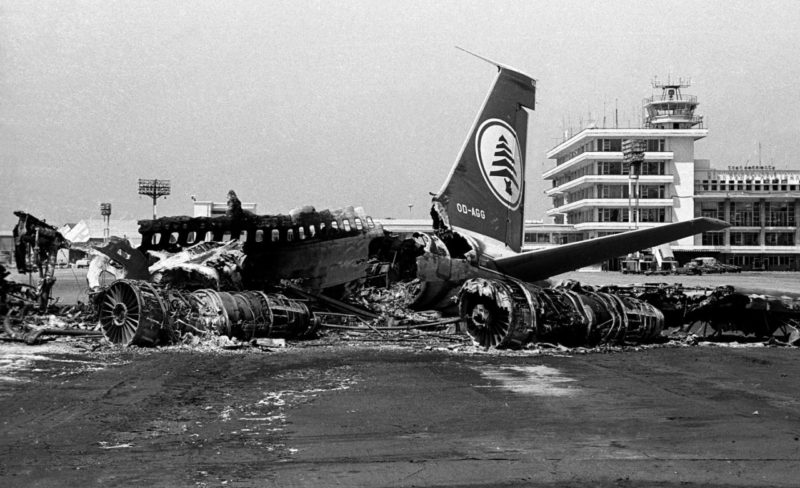
It was possible to paper over the cracks in Lebanon for a few more years, with only isolated incidents, such as one in August 9, 1973, when Israel identified an MEA Caravelle flight as having four wanted Palestinian militants onboard. The flight was escorted to Israel by Israeli jet fighters after takeoff from Lebanon, but the militant passengers were not among the passengers.
On August 16th, another MEA jetliner made an unexpected visit to Israel. A Libyan passenger hijacked an MEA 707 to Tel Aviv with 125 passengers onboard as a gesture of goodwill towards Israel. The aircraft was returned to Lebanon after the passengers were rescued.
The Paris of the Middle East was heading for the rocks after this incident. The civil war in Lebanon began in 1975 with fighting between Palestinians and Christians. The number of armed groups in Lebanon grew rapidly because of the mosaic of ethnic identities. The national army split along confessional lines and what had been a major hub of trade and leisure quickly became global shorthand for urban breakdown and chaos.
The fighting began just as the three Boeings were delivered to MEA, but two of them were leased to Saudia Airlines. Despite the fighting in the city which quickly engulfed the harbourside hotels and downtown business district, MEA was able to maintain a semblance of normality for the rest of 1975. A bomb exploded in the forward baggage compartment of the Cedarjet 438 that was flying from Riyadh to Dubai. The culprits were never found.
The airport came under rocket and mortar attack on June 27 and another 720B was destroyed on the ground. A crew member was killed and two others were injured when passengers deplaned. The fighting overwhelmed the ability of the authorities to secure the airport. MEA had to find work in other markets from a temporary base in Paris because Lebanon's gateway to the world closed for 168 days.
After the restart of flights on June 5, 1977, a wheelchair-bound passenger hijacked a 707-323C and took it to Kuwait, where he was released by the authorities and returned to Lebanon.
On January 16, 1979 a 707-323C was hijacked by six skyjackers with the intention of holding a press conference in Larnaca. The flight was refused landing permission by the Cyprus authorities, who instead returned to Lebanon where the media event took place prior to the six surrendering.
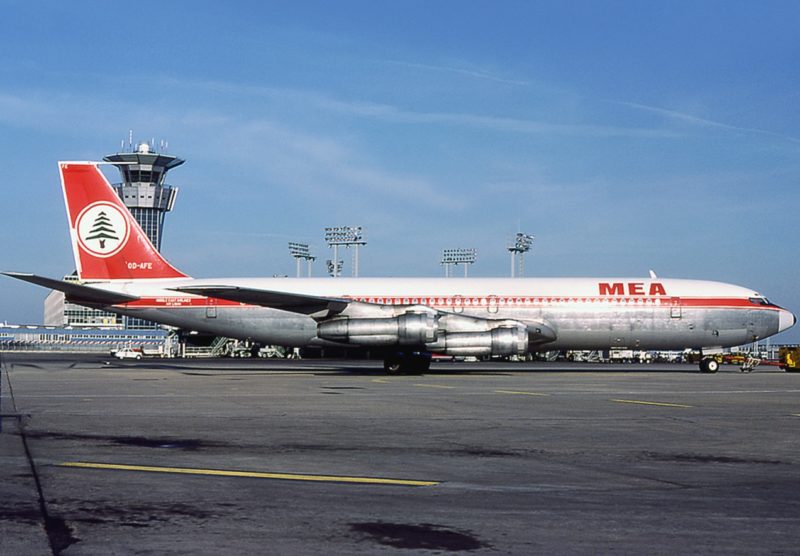
The event at the airport on July 23, 1979 was not a deliberate act. A Trans Mediterranean Airways plane crashed in the course of training a new group of pilots. The training captain, flight engineer, safety pilot, and three cadets died.
The civil war and its toll on civil aviation did not abate during the turn of the decade. On January 18, 1980, a teenager from Lebanon hijacked a 720-023B and went to Iran to try to find a missing cleric. The youth was allowed to hold a press conference before surrendering. After hijacking a Baghdad-bound 720B, a man with his wife and four children boarded a plane at Saddam International, where he gave himself up to the Iraqi police. On May 23 a flight bound for Bahrein only got as far as Amman before it was forced to land due to a bomb threat.
Passengers and crew were lucky to escape injury when a bomb exploded on the ramp at Lebanon on the last day of 1981.
MEA was trying to run profitable and regain its place as one of the world's great airlines. New seats were installed in the 707s and new destinations were opened, including the capital of Tunisia and the capital of Soviet Armenia. The construction of an enormous maintenance hangar at Beirut was started anticipating an end to the conflict.
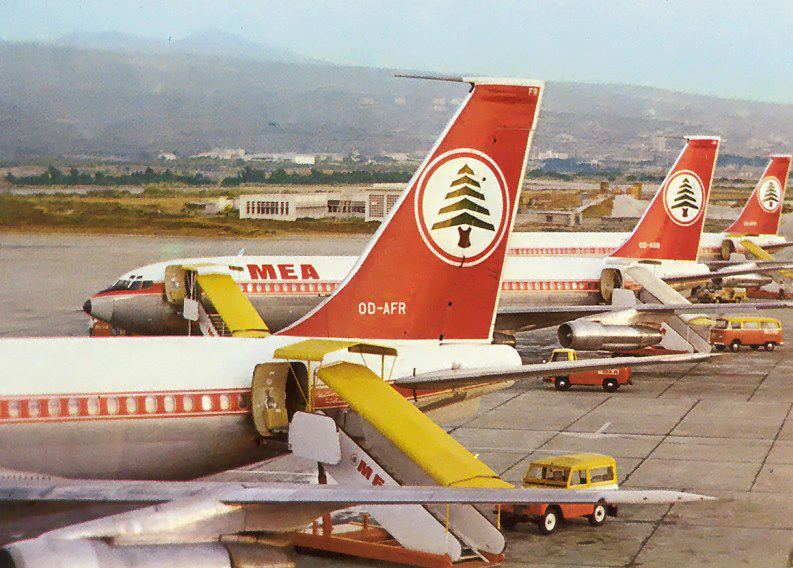
The worst was yet to come. The PLO was driven out of Lebanon by Israel in 1982.
Beirut was cut off from the world and the airport was closed for 115 days. Six 707s and 720Bs were destroyed on the ground, with two others severely damaged.
The arrival of a multi-national peacekeeping force in early 1983 allowed for some optimism, and the two jumbos leased to Saudia returned, enabling MEA to cross the Atlantic for the first time, opening up service to New York via Paris.
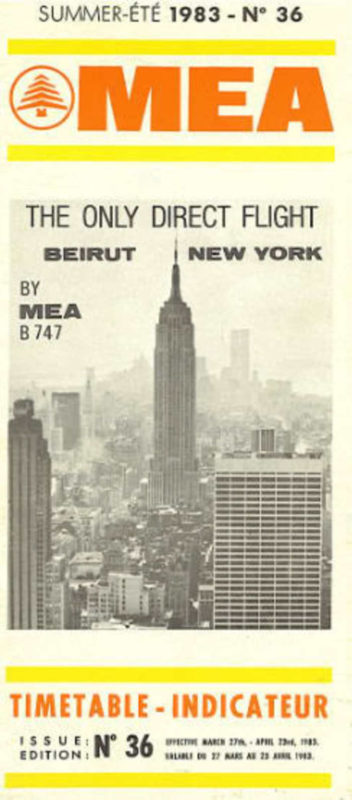
On October 23, a suicide truck bomber killed 241 people at the US Marines base at the airport. It was the worst US military loss of life since Vietnam. The French military base in the city was attacked. Lebanon was left to its fate when the peacekeepers withdrew. In the first half of 1984 the airport was closed for most of the time, causing losses of $46 million.
The first Cedarjet touched down after the airport reopened. The lawless environment in which the airline operated soon reasserted itself, with a 707 near the end of a flight from Abu Dhabi to Lebanon hijacked by a man with a molotov cocktail. Low on fuel, the captain was able to convince the man to accept a landing in Lebanon, where he gave a press conference before surrendering.
MEA's executive vice-president for operations Abed Hoteit would go to the control tower when the shooting started to talk to inbound flights and aircraft waiting for start-up clearance. As soon as there was a lull in the shooting, Hoteit would let the flights come in. In the case of fighting in the vicinity of the airport, the airline's policy was to wait for a lull and then perform an expedited departure.
MEA’s 275 pilots, all but 13 of whom were Lebanese, did not take inordinate risks. But they flew where others feared to because of their intimate knowledge of the steep mountains and narrow plains around Beirut airport, and because they regarded bringing their aircraft home to Lebanon as a national duty.
In 1984 the airline said it had lost over $100 million since the start of the war. Staff took a number of pay cuts to help mitigate the costs. No amount of persuasion could convince travellers to visit Lebanon. The founder of Air Transport World was honoured with a special award at the annual event in New York.
The first decade of Lebanon's civil war was bad for MEA. When jet fuel could not be delivered to the airport, a jumbo jet would be dispatched empty to Cyprus, where the fuel would be filled to the brim.
On February 23, an airport security guard hijacked an MEA 707 that had just finished boarding and was ready to fly to Paris. The hijacker ordered passengers to leave using escape slides, but the militiamen began firing and the captain was ordered to start taxiing. A passenger was killed and others were injured when a jet blast and machine-gun fire ripped a hole in the left wing. The aircraft took off with doors open and slides hanging off of it. The hijacking was done to get better pay for airport security staff and to protest the high cost of living. A phone call from the hijacker's supervisor promised an investigation into the financial claims after he landed in Cyprus. The aircraft was met by an airport authority vehicle and the hijacker was free to return to his home in the airport suburbs. In the 1980s, Lebanon was a lawless place.
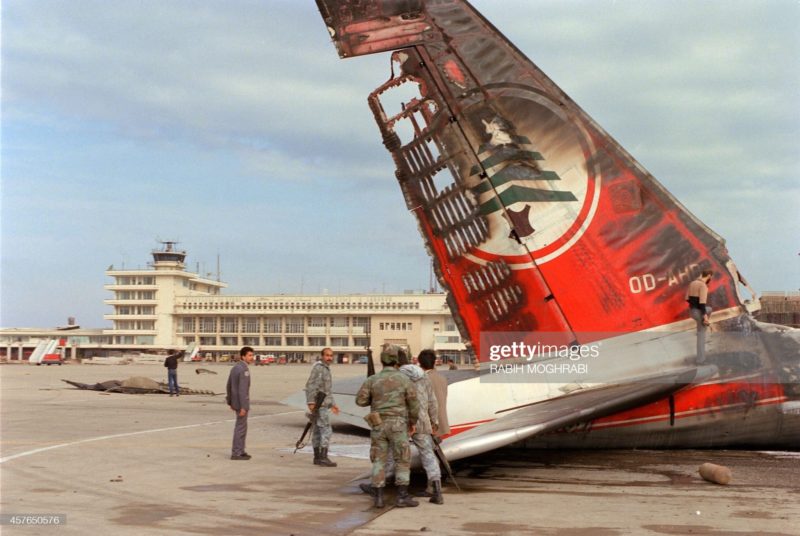
On April 1, a hijacker took over a plane en route to Saudi Arabia with claims of having a gun and a bomb and demanded that the government of Lebanon help guerillas fighting the Israeli occupation of southern Lebanon. The hijacker was arrested by the Saudi police when the aircraft landed.

On June 11, a Royal Jordanian 727 was hijacked by five Shiite Lebanon armed with machine guns and explosives just before it was to leave for Amman. They wanted to be flown to Tunisia but lacked fuel and had to stop in Cyprus. The aircraft took off again from Palermo, but spent two hours on a flight to nowhere before landing in the early hours of June 12. The aircraft was destroyed by explosives. A Palestinian man took over an MEA 707 that had just landed from Cyprus and demanded to be flown to Amman. After allowing the passengers and cabin crew off the plane, it taxied past the wreck of the plane and flew to Jordan where he was arrested.
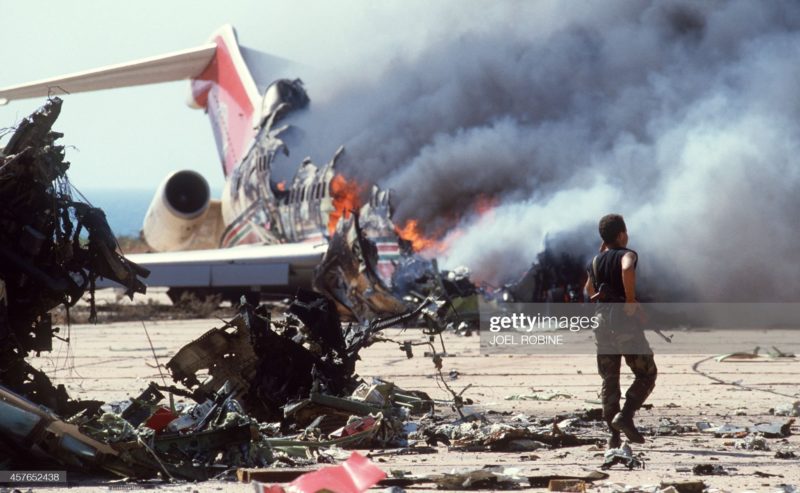
TWA flight 847 was hijacked after takeoff from Athens on a flight that was to feed a jumbo bound for Boston and Los Angeles. The hijackers were members of Hezbollah and Islamic Jihad. Nineteen passengers were exchanged for fuel in Beirut, and another 20 passengers were released in Algiers. 40 hostages were taken from the plane and held in a prison in the suburbs of Lebanon after the aircraft made two more return trips to Algiers. After two weeks in captivity, they were released after one of the main demands of the hijackers, the release of 700 Shia Lebanon held in Israeli prisons. The US Navy diver on the TWA flight was killed in the course of events.
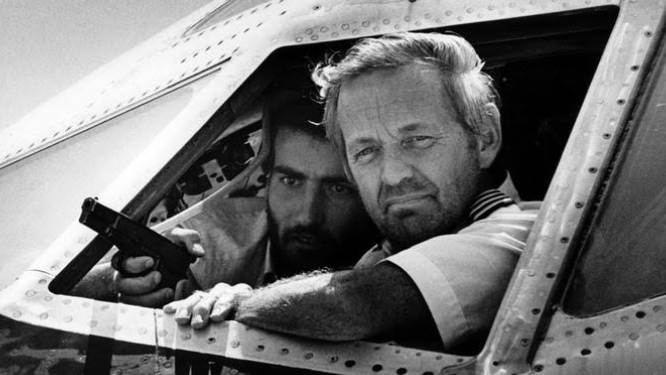
The MEA was damaged by the TWA 847 incident when members of the transport workers union in New York refused to service the MEA flight. In August, MEA flew a TWA crew to Lebanon to pick up their stranded 727, N64339, and ferry it to the United States for an upgrade and return to service, but Lebanon's civil aviation sector was in tatters. On August 21, a pair of 720Bs were destroyed by fighting in Lebanon.
On January 8, 1987, a 707 was destroyed by shelling, just after 126 passengers had deplaned. The airport was closed on February 1 for another period of fighting.
In the late 1980s, the security situation on the ground in Lebanon was so bad that airline passengers had to take ferry rides from the ports of Tripoli and Jounieh to get to the airport.
The MEA began a double daily air shuttle from Lebanon to Kleyate Airport, a mostly unused military facility in the north of the country. The flight time between the two airports was fifteen minutes. The morning rotation was numbered Cedarjet 1 and the evening rotation was Cedarjet 3. Locals used the flights to get from one side of the city to the other to get to work or to see friends and family on the other side.
After fifteen years of fighting, the war ended in October of 1990.
150,000 Lebanese had died, including 40 MEA employees. 12 720s and three 707s were destroyed. No corner of the country was unscarred.
MEA's vintage Boeings, having provided an essential lifeline from Lebanon to the world, now performed their final act, the conduit for the economic boom of the post-war peace dividend. The citizens of Lebanon who had fled abroad began to return to their homes and businesses, construction engineers and salespeople poured in to assist the mammoth rebuilding effort, and tourists were drawn by the sandy beaches, ancient culture, and cool mountain heights which now had an extra layer of notoriety.
The fleet of 707s and 720s was flown round the clock as passenger numbers spiked. The last two 720Bs, OD-AGB and -AFM, were mostly active for crew training and ad hoc equipment substitution but returned to scheduled service in June 1994. The two brave soldiers left Lebanon in 1995 for new lives at Whitney Canada. MEA opened up new long-haul flights to Australia via Singapore and Sao Paolo, with the return of its jumbo jets.
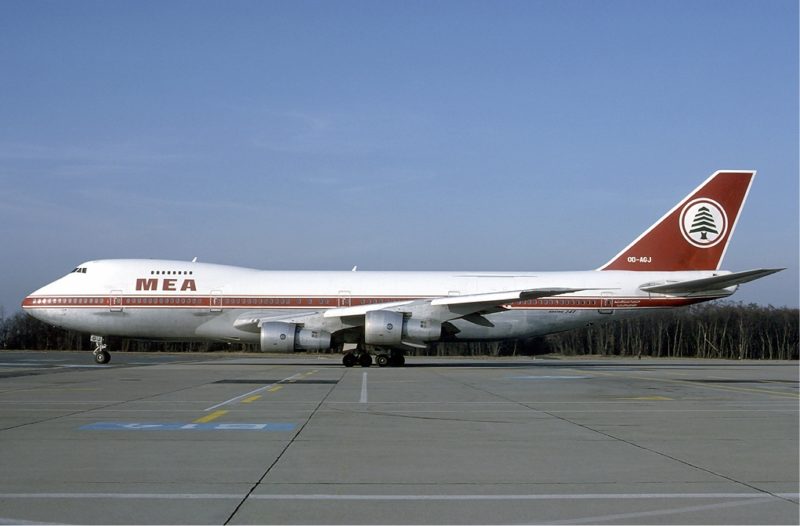
The last MEA 707 destinations were in the Persian Gulf and closer to home, on short one hour where fuel burn mattered least, because of new noise legislation that punished older hardware with landing charges.
In the 1990s, airline enthusiasts who wanted to fly on a 707 turned up regularly on MEA flights, but the airline still saw itself as a top airline brand and took no pride in being the last mainstream passenger 707 operator. Lebanon's tribes take great pride in the fact that their national carrier gave them a lifeline. The survival of their nation depended on it, and MEA never let them down.
The cover image is Rabih Moghrabi.